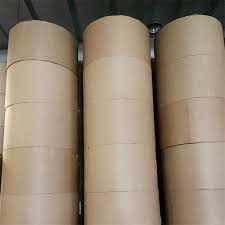When it comes to packaging, crafting, or design, materials play a crucial role in determining the quality and durability of the final product. Two widely used materials in these fields are Kraft Paper and Art Board. Both have distinct properties and applications, yet they often complement each other in creative and industrial projects. This article explores the characteristics, differences, and practical uses of Kraft Paper and Art Board to help you better understand when and why to use each material.
What is Kraft Paper?
Kraft Paper is a type of paper known for its strength and durability. It is made from wood pulp processed by the kraft process, which uses chemical methods to convert wood into pulp without damaging the fibers. This results in a paper that is both tough and flexible, with a natural brown color that is iconic in packaging and crafting.
Properties of Kraft Paper
Kraft Paper is appreciated for its toughness and resistance to tearing, making it an ideal choice for packaging heavy or sharp-edged items. It is biodegradable and recyclable, aligning with environmentally conscious manufacturing and consumer trends. Besides its natural brown hue, Kraft Paper can be bleached to produce white Kraft Paper, which is sometimes preferred for aesthetic reasons.
Common Uses of Kraft Paper
- Packaging Material: It is frequently used for wrapping goods, covering boxes, and filling voids in shipping containers to protect items during transit.
- Crafting and Design: Artists and designers use Kraft Paper for sketches, drawings, and paper crafts due to its rustic look and sturdy texture.
- Eco-Friendly Products: Many companies prefer Kraft Paper for their sustainable packaging solutions because it is compostable and made from renewable resources.
What is Art Board?
Art Board, sometimes called illustration board or Bristol board, is a thicker, more rigid material made from paper pulp pressed into a dense sheet. It has a smooth surface, often coated or treated, making it perfect for various art techniques and professional presentations.
Properties of Art Board
Art Board’s stiffness and durability set it apart from regular paper. It typically comes in white but can be found in other colors. Its surface can be smooth or slightly textured, depending on the type of Art Board, allowing it to accommodate mediums such as watercolor, acrylic, ink, and pencil with ease.
Common Uses of Art Board
- Fine Art and Illustration: Artists use Art Board for creating detailed drawings, paintings, and mixed media artworks because it supports a wide range of materials without warping.
- Model Making and Prototyping: Designers and architects use Art Board for constructing models, thanks to its firmness and ease of cutting.
- Presentation and Display: Art Board is also used for mounting photographs, prints, and other artwork for framing or display purposes.
Comparing Kraft Paper and Art Board
While Kraft Paper and Art Board both belong to the paper family, their differences in composition, texture, and rigidity mean they serve very different functions.
Strength and Flexibility
Kraft Paper is flexible yet strong, ideal for wrapping and protective uses, whereas Art Board is rigid and supportive, intended for display and artistic applications.
Surface Finish and Appearance
Kraft Paper has a natural, rustic look with a rough texture, often brown but also available in white. Art Board typically features a smooth, bright white surface that enhances color vibrancy and detail in artworks.
Environmental Impact
Both materials can be environmentally friendly, but Kraft Paper is especially known for being biodegradable and compostable. Art Board, depending on its coating and thickness, may have a more complex recycling process.
How Kraft Paper and Art Board Complement Each Other
In some projects, Kraft Paper and Art Board are used together to maximize their unique properties. For example, in packaging design, Kraft Paper may be used for the external wrapping because of its strength and eco-friendliness, while Art Board could serve as an internal support or backing to protect fragile items.
Artists and crafters might use Kraft Paper for preliminary sketches and rough work because it is inexpensive and durable, then transfer their final work to Art Board for presentation due to its smooth and professional finish.
Benefits of Using Kraft Paper
One of the primary benefits of Kraft Paper is its sustainability. Made from renewable wood pulp, it provides a responsible alternative to plastic and other non-biodegradable packaging materials. Its strength allows for reliable protection during shipping, reducing product damage and waste.
Moreover, Kraft Paper’s texture and natural color make it highly popular in eco-friendly branding. It offers a tactile and visual experience that appeals to consumers who favor natural, organic aesthetics.
Benefits of Using Art Board
Art Board excels in artistic versatility. Its smooth surface allows for detailed and precise work, whether it’s ink, watercolor, or pencil. Its sturdiness also means finished pieces can be handled, framed, or transported without damage, maintaining the integrity of the artwork.
Additionally, Art Board’s thickness and rigidity make it suitable for creative prototyping and structural models, providing a reliable medium for designers to visualize and communicate their ideas.
Choosing Between Kraft Paper and Art Board
Deciding whether to use Kraft Paper or Art Board depends largely on the intended purpose of the project. If you need a durable, flexible, and eco-friendly material primarily for packaging or rough crafting, Kraft Paper is the go-to choice. For artistic work, presentations, or projects requiring a rigid support, Art Board is the better option.
Consider the desired aesthetic, durability, and environmental impact. Combining both materials strategically can often yield the best results.
Conclusion
Kraft Paper and Art Board serve distinct yet sometimes overlapping roles in art, packaging, and design. Understanding their differences and benefits allows creators, manufacturers, and consumers to make informed decisions about their projects.
